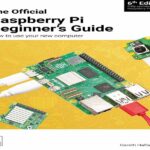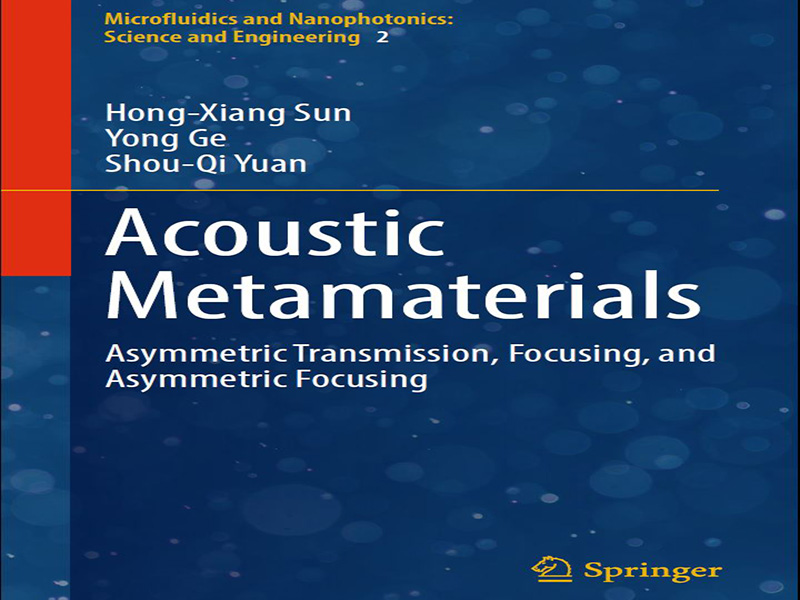- عنوان: Acoustic Metamaterials Asymmetric Transmission, Focusing, and Asymmetric Focusing
- نویسنده: Hong-Xiang Sun, Yong Ge, Shou-Qi Yuan
- حوزه: مواد آکوستیک
- سال انتشار: 2025
- تعداد صفحه: 385
- زبان اصلی انگلیسی
- نوع فایل: pdf
- حجم فایل: 15.7 مگابایت
قلمرو آکوستیک از دیرباز سنگ بنای تمدن بشری بوده و امکان ارتباط، اکتشاف و قدردانی از هنرها را فراهم کرده است. از ملودیهای هماهنگ موسیقی گرفته تا وضوح زبان گفتاری و از دقت تصویربرداری اولتراسونیک گرفته تا دسترسی به تشخیص سونار، امواج صوتی در وجود مدرن ما نفوذ کرده و آن را غنی میکنند. با این حال، مواد سنتی کنترل محدودی بر این امواج ارائه دادهاند و پتانسیل نوآوری در کاربردهای صوتی را محدود کردهاند. ظهور متامواد صوتی به عنوان یک راه حل دگرگونکننده ظهور کرده است که دستکاری بیسابقهای از امواج صوتی را فراهم میکند و نویدبخش دوران جدیدی در فناوری صوتی است. متامواد صوتی، کامپوزیتهای مصنوعی با ابعاد زیر طول موج هستند که خواص صوتی آنها نه توسط ویژگیهای ذاتی مواد تشکیلدهنده آنها، بلکه توسط طراحی واحدهای ساختاری آنها تعیین میشود. از طریق مهندسی دقیق این واحدها و پیکربندیهای آنها، متامواد صوتی میتوانند به طور دقیق انتشار صدا را کنترل کنند و از محدودیتهای مواد معمولی فراتر روند و انواع پدیدهها و عملکردهای جدید را ممکن سازند. در سالهای اخیر، حوزه متامواد صوتی شاهد پیشرفتهای چشمگیری بوده و تحقیقات پیشگامانه زیادی را به همراه داشته است. در میان این موارد، سه حوزه تحقیقاتی کلیدی توجه قابل توجهی را به خود جلب کردهاند و پتانسیل عظیمی را برای کاربردهای عملی نشان دادهاند: انتقال نامتقارن آکوستیک، تمرکز آکوستیک و تمرکز نامتقارن آکوستیک. انتقال نامتقارن آکوستیک، عمل متقابل مرسوم انتشار صدا در سیستمهای آکوستیک را به چالش میکشد و امواج آکوستیک را قادر میسازد تا به صورت نامتقارن در جهتهای مخالف حرکت کنند. این ویژگی، شبیه به یک دیود الکترونیکی، انتقال یک طرفه آکوستیک را تسهیل میکند و نویدبخش کاربردهایی در دیودها و ایزولاتورهای آکوستیک است. به عنوان مثال، استفاده از انتقال نامتقارن میتواند منجر به توسعه ایزولاتورهای آکوستیک کارآمد و فشرده شود که به طور موثر بازتابها و تداخل را در سیستمهای آکوستیک کاهش میدهند و در نتیجه عملکرد و پایداری آنها را افزایش میدهند. تمرکز آکوستیک با هدف متمرکز کردن انرژی صدا در یک منطقه خاص، فراتر رفتن از محدودیتهای پراش لنزهای آکوستیک سنتی و دستیابی به دستکاری صدا در مقیاس زیر طول موج انجام میشود. لنزهای آکوستیک معمولی توسط محدودیتهای پراش محدود میشوند که مانع از تمرکز آکوستیک با وضوح بالا میشود. با این حال، متامواد آکوستیک میتوانند جبهههای موج آکوستیک را از طریق سلولهای واحد طراحی شده خاص، به طور دقیق مدوله کنند، بر محدودیتهای پراش غلبه کنند و امکان تمرکز صدا در زیر طول موج را فراهم کنند. این پیشرفت، انقلابی در زمینههایی مانند تصویربرداری صوتی با وضوح بالا و درمان صوتی دقیق ایجاد کرده است. به عنوان مثال، لنزهای متامواد صوتی میتوانند تصویربرداری اولتراسونیک با وضوح بسیار بالا از بافتهای انسانی را تسهیل کنند و پایه دقیقتری برای تشخیص زودهنگام بیماری فراهم کنند. تمرکز نامتقارن صوتی، مزایای انتقال و تمرکز نامتقارن را با هم ترکیب میکند و تمرکز موج صوتی را در یک جهت خاص افزایش میدهد در حالی که انتشار در جهت مخالف را سرکوب میکند. این ویژگی پتانسیل کاربرد در ارتباطات صوتی جهتدار و درمان اولتراسوند متمرکز با شدت بالا را دارد. به عنوان مثال، تمرکز نامتقارن میتواند برای ساخت آنتنهای صوتی جهتدار برای ارتباط صوتی با دقت بالا و از راه دور استفاده شود. همچنین میتواند چالشهای موجود در درمان اولتراسوند متمرکز، مانند اثرات مخرب امواج صوتی منعکسشده با شدت بالا بر روی مبدلها و بافتهای سالم اطراف را برطرف کند و در نتیجه هزینههای درمان را کاهش داده و دقت را بهبود بخشد. در خصوص پیشینه تحقیق، با حمایت برنامه ملی تحقیق و توسعه کلیدی چین تحت کمک هزینه شماره 2020YFC1512403 و بنیاد ملی علوم طبیعی چین تحت کمک هزینه شمارههای 12274183 و 12174159، گروه ما کار خود را در طول دهه گذشته در زمینه انتقال نامتقارن آکوستیک، فوکوس آکوستیک، فوکوس نامتقارن آکوستیک و کاربردهای مرتبط مبتنی بر متامواد آکوستیک خلاصه و سازماندهی کرده است. یافتههای تحقیقاتی کامل با دقت انتخاب شدهاند و آخرین پیشرفتها در این زمینه برای تدوین این کتاب گنجانده شده است. این کتاب به عنوان مرجعی برای متخصصان فیزیک، آکوستیک، سونوگرافی پزشکی، آزمایش غیرمخرب و مهندسی مکانیک قدرت در نظر گرفته شده است. این کتاب در ده فصل سازماندهی شده است. فصل 1، مقدمه، مروری بر مفاهیم اساسی، توسعه تاریخی، نقاط داغ تحقیقاتی فعلی و مسیرهای آینده متامواد آکوستیک و شاخههای کلیدی آنها ارائه میدهد. فصل ۲، نظریه پایه، مجموعهای از اصول و روشهای بنیادی برای دستکاری صدا در فضاهای دوبعدی و سهبعدی مبتنی بر فرامواد آکوستیک، از جمله نظریه تداخل، نظریه محیط مؤثر، روش اجزای محدود، قانون اسنل تعمیمیافته، نظریه تبدیل مد و نظریه نواری کریستالهای صوتی را معرفی میکند.
The realm of acoustics has long been a cornerstone of human civilization, enabling communication, exploration, and the appreciation of the arts. From the harmonious melodies of music to the clarity of spoken language, and from the precision of ultrasonic imaging to the reach of sonar detection, acoustic waves permeate and enrich our modern existence. Yet, traditional materials have offered limited control over these waves, constraining the potential for innovation in acoustic applications. The advent of acoustic metamaterials has emerged as a transformative solution, providing unprecedented manipulation of acoustic waves and heralding a new era in acoustic technology. Acoustic metamaterials are artificially structured composites with subwavelength dimensions, whose acoustic properties are determined not by the intrinsic characteristics of their constituent materials, but by the design of their structural units. Through meticulous engineering of these units and their configurations, acoustic metamaterials can precisely control the propagation of sound, transcending the limitations of conventional materials and enabling a variety of novel phenomena and functionalities. In recent years, the field of acoustic metamaterials has witnessed remarkable advancements, yielding a wealth of groundbreaking research. Among these, three key research areas have attracted significant attention and demonstrated immense potential for practical applications: acoustic asymmetric transmission, acoustic focusing, and acoustic asymmetric focusing. Acoustic asymmetric transmission challenges the conventional reciprocity of sound propagation in acoustic systems, enabling acoustic waves to travel asymmetrically in opposite directions. This characteristic, akin to an electronic diode, facilitates acoustic one-way transmission and holds promise for applications in acoustic diodes and isolators. For instance, leveraging asymmetric transmission can lead to the development of efficient, compact acoustic isolators that effectively mitigate reflections and crosstalk in acoustic systems, thereby enhancing their performance and stability. Acoustic focusing aims to concentrate sound energy within a specific region, surpassing the diffraction limits of traditional acoustic lenses and achieving subwavelength-scale sound manipulation. Conventional acoustic lenses are constrained by diffraction limits, which hinder high-resolution acoustic focusing. Acoustic metamaterials, however, can precisely modulate acoustic wavefronts through specially designed unit cells, overcoming diffraction limits and enabling subwavelength focusing of sound. This breakthrough has revolutionized fields such as high-resolution acoustic imaging and precise acoustic therapy. For example, acoustic metamaterial lenses can facilitate ultra-high-resolution ultrasonic imaging of human tissues, providing a more accurate foundation for early disease diagnosis. Acoustic asymmetric focusing combines the advantages of asymmetric transmission and focusing, enhancing acoustic wave concentration in a particular direction while suppressing propagation in the opposite direction. This property holds potential for applications in directional acoustic communication and high-intensity focused ultrasound therapy. For instance, asymmetric focusing can be utilized to construct directional acoustic antennas for long-distance, high-fidelity acoustic communication. It can also address challenges in focused ultrasound therapy, such as the damaging effects of high-intensity reflected sound waves on transducers and surrounding healthy tissues, thereby reducing treatment costs and improving accuracy. Regarding the research background, with the support of the National Key Research and Development Program of China under Grant No. 2020YFC1512403, and the National Natural Science Foundation of China under Grant Nos. 12274183 and 12174159, our group has summarized and organized its work over the past decade on acoustic asymmetric transmission, acoustic focusing, acoustic asymmetric focusing, and related applications based on acoustic metamaterials. Mature research findings have been carefully selected, and the latest advancements in the field have been incorporated to compile this book. It is intended to serve as a reference for professionals in physics, acoustics, medical ultrasound, non-destructive testing, and power mechanical engineering. The book is organized into ten chapters. Chapter 1, Introduction, provides an overview of the fundamental concepts, historical development, current research hotspots, and future trajectories of acoustic metamaterials and their key branches. Chapter 2, Basic Theory, introduces a series of fundamental principles and methods for sound manipulation in 2D and 3D spaces based on acoustic metamaterials, including the interference theory, effective medium theory, finite element method, generalized Snell’s law, mode conversion theory, and band theory of sonic crystals. Chapters 3 and 4, Acoustic Asymmetric Transmission, present several AAT systems designed with underwater plate-like metamaterials and airborne metamaterials, and discuss their potential applications in architectural acoustics, noise control, and medical ultrasound in detail. Chapters 5–7, Acoustic Focusing, showcase a series of AF lenses designed with ring-shaped metamaterials, phase-controlled metamaterials, and thermoacoustic phase-controlled metamaterials, exploring their applications in underwater signal detection, medical ultrasound therapy, acoustic communication, and acoustic energy harvesting. Chapter 8, Acoustic Asymmetric Focusing, demonstrates a variety of AAF lenses designed with asymmetric modulation metamaterials and discusses their potential applications in focused ultrasound therapy and medical ultrasound imaging. Chapter 9, Three-Dimensional Acoustic Focusing and Asymmetric Focusing, presents several types of 2D acoustic lenses designed with phasecontrolled metamaterials. These 2D lenses can simultaneously achieve a combination of focusing and other effects in 3D space, promoting their practical applications in non-contact manipulation for trapping particles, medical ultrasound imaging and treatment. Chapter 10, Conclusions, Challenges, and Future Prospects, summarizes key findings in acoustic metamaterials, covering AAT, AF, and AAF systems. It highlights advancements in sound manipulation, identifies challenges, and outlines future research directions, including broadband devices, 3D wavefront control, and machine learning. During the process of conducting relevant research and writing this book, we benefited from the guidance and assistance of several respected individuals, including Prof. Shu-yi Zhang, Prof. Xiao-jun Liu, Prof. Yun Lai, and Prof. Xiaozhou Liu from Nanjing University; Prof. Baile Zhang from Nanyang Technological University; Prof. Zhengyou Liu from Wuhan University; Prof. Menglu Qian and Associate Prof. Zheng Xu from Tongji University; Assistant Prof. Haoran Xue from the Chinese University of Hong Kong; Prof. Yihao Yang from Zhejiang University; Associate Prof. Yi-jun Guan, Dr. Ding Jia, and Prof. Qiao-rui Si from Jiangsu University. We are also grateful for the contributions of Ph.D. student Yin Wang; postgraduate students Jian-ping Xia, Jiao Qian, and Hong-yu Zou; and undergraduate students Chen Liu, Yu-lei Huang, Wen-ting Gao, Jia-he Chen, An-ru Hou, Tian-chi Zhang, Jia-li Yin, and others who participated in various aspects of this work. We would like to express our deepest gratitude to all of them. The author has strived to maintain a serious and rigorous approach in writing this book. However, we acknowledge that there may still be shortcomings. We warmly welcome readers’ feedback, criticisms, and corrections. Together, may we contribute our modest efforts to advancing the field of acoustic metamaterials, particularly in the areas of asymmetric transmission, focusing, and asymmetric focusing.
این کتاب را میتوانید بصورت رایگان از لینک زیر دانلود نمایید.
Download: Acoustic Metamaterials




































نظرات کاربران